Dire Straits: Brothers in Arms in Dolby Atmos & 40th Anniversary Edition Box Set

Forty years ago this month in May 1985, the savior of the then-burgeoning compact disc format arrived in the name of Dire Straits’ fifth studio album Brothers in Arms, a career-defining release that became the first CD to ever sell a million copies. The scope and worldwide popularity of BIA cemented the Straits legacy forevermore—and, as bandleader Mark Knopfler told me for a retrospective feature that appears in the current edition of our sister pub/site Stereophile, “Brothers in Arms has certain sonic qualities and qualifications that helped it reach critical mass. [. . .] Marry that with how people were feeling about that new CD technology, the Steve Barron video for ‘Money for Nothing’ with those new computer graphics, and a couple of hit singles, and you got an album that turned into a big snowball going down a very long hill.” (My full story on BIA40, “Rock of Life,” appears in the June 2025 print edition of Stereophile magazine, and it will subsequently be posted in the Music and Recording Features section on their site fairly soon. I will add a link to that post here, once it goes live.)
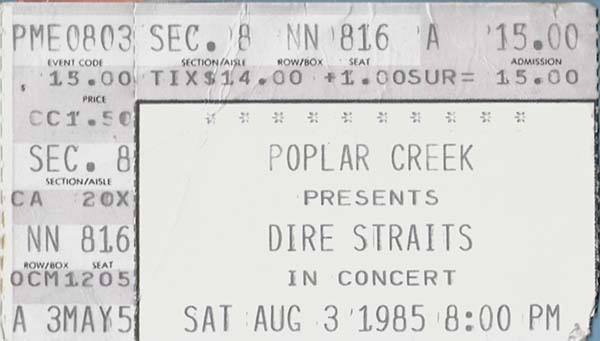
To commemorate this key milestone, Vertigo/Mercury/Universal Music Recordings pulled out all the stops by releasing a 40th anniversary edition of BIA in multiple formats, including separate 5LP and 3CD sets that both include a previously unreleased 14-track live show recorded at Municipal Auditorium in San Antonio, Texas, on August 16, 1985—exactly 13 days after I saw that very same tour at Poplar Creek in Hoffman Estates, Illinois (see above for my, yes, $15 ticket for that show!)—plus a standalone 1LP edition mirroring the original’s abbreviated vinyl release, and a 1BD High Fidelity Pure Audio edition with an array of mix options including a new Dolby Atmos mix done by Knopfler’s right-hand man since the early ’80s, Guy Fletcher.
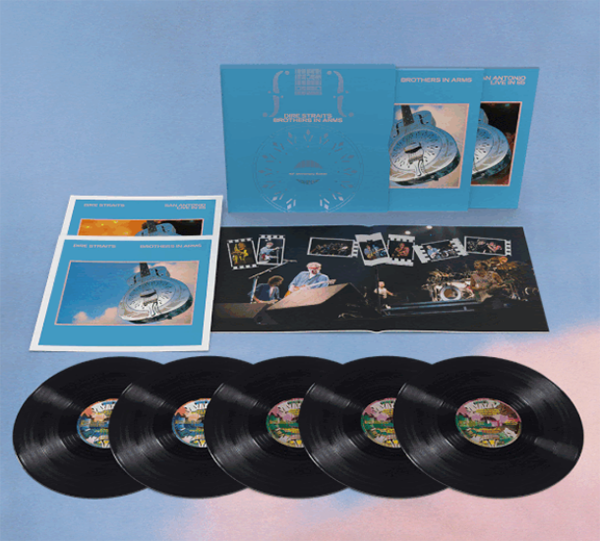
Naturally, being the completist that I am, I pre-ordered every one of these new versions of BIA40 back in March, knowing they would sell out almost immediately—and they absolutely did—but you can still find all of them available on Discogs at price levels relatively comparable to what I paid (as of this posting, at least). The new, abbreviated 1LP set is also on Amazon and at other select retailers and record shops. For the record, here’s what those pre-orders cost me, in pounds (followed by the U.S. dollar equivalent). The 5LP set, which comes in a nice and sturdy slipcase, has a full-size 16-page saddle-stitched booklet with exclusive new liner notes and unseen photos and also includes two bonus art prints, cost £117.99 (about $160 U.S.). The digipak 3CD set ran me £19.99 ($27), and the 1LP edition was £29.99 ($40). The Blu-ray, which I ordered from the always reliable SDE Shop, ran me £25 ($34). Each version arrived separately over the course of the past week or so—all of them worth the wait, I might add.
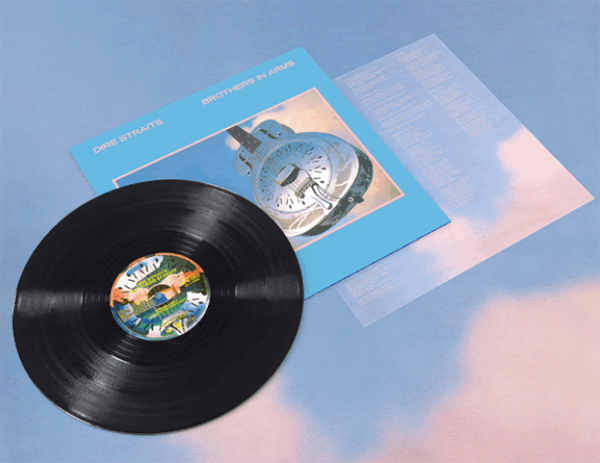
The 1LP set is a bit of an of-era peculiarity, since the full, original BIA CD ran just over 55 minutes and wouldn’t have easily fit on a single LP without compromising the what co-producers Neil Dorfsman and Mark Knopfler had approved. Hence, they trimmed some time off every Side One track except the hit single “Walk of Life” (No. 7 in the U.S., No. 2 in the UK) but left Side Two intact to cut the original 1985 LP down to 45 minutes. Since I didn’t own a CD player at the time of the album’s release (shh, don’t tell!), I also bought the BIA cassette the same day I got the LP so I could have the full-length versions of those slimmed-down Side 1 tracks—“So Far Away,” “Money for Nothing,” “Your Latest Trick,” and “Why Worry”—at the ready. Incidentally, the proclamation at the bottom of the BIA cassette’s cover read, “This cassette features extended versions of four songs. Blank tape at end of Side Two is necessary to duplicate sequence of LP.” (Yep, that was a thing back then.) I also purchased the comparable BIA 45s and import 10-inchers, some of which had fuller song lengths and live bonus tracks to boot.
Playing the BIA cassette over and over—especially after rewinding and repeating Side One many, many times—made listening to the 1985 LP somewhat jarring/disappointing, because “Money for Nothing” (No. 1 U.S., No. 4 UK) sure didn’t feel right after losing a full minute, nor did “Why Worry,” seeing how it lost about three full minutes on the tail end that featured Omar Hakim’s stellar drumming showcase, as buttressed by Knopfler’s supportive guitar noodling. That said (Pt. 1)—if you want to hear how BIA originally appeared on vinyl in its respectful yet abbreviated form, this is the version to get.
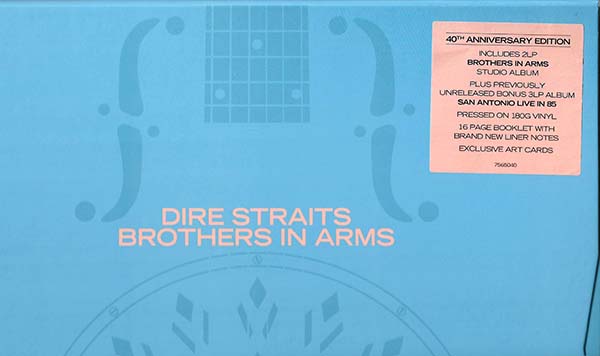
That said (Pt. 2)—if you want to hear BIA breathe on vinyl as it really should, its full 55 minutes get spread across the first 2LPs in the 5LP set, with the San Antonio live portion spread out over the remaining 3LPs. The vinyl cutting was done by Miles Showell at Abbey Road (and he also cut the half-speed-mastered 2LP edition of BIA that was released in 2020).
Having the San Antonio set in professionally mastered form is a real treat—and it’s also the perfect companion to the Straits’ Live 1978 to 1992 12LP/8CD box sets released in 2023-24, which don’t include anything from that 1985 tour. Naturally, I happen to have that 1985 San Antonio show on a pair of bootlegs—one of them a white-label 2LP edition I paid way too much for back in college, the other a 2CD set on the Italian Living Legends “imprint.” The source for those boots was the original King Biscuit Flower Hour broadcast of that San Antonio gig, which aired on numerous FM stations over two consecutive weekends on November 10 and November 17, 1985. Both boot options were certainly good enough in order to have decent-sounding representations of the setlist I remember seeing in Illinois earlier that August, but they both have that “recorded off the air” feel to them that’s somewhat less than audiophile-quality.
Thus, having a professionally mixed and mastered version of that S.A. show is much more preferable, so those two boots have officially been permanently shelved as a result. For the record, Guy Fletcher did the mixing at British Grove Studios in November 2024, and the aforementioned Miles Showell did the mastering at Abbey Road Studios in December 2024. Each LP in the San Antonio portion of the box reside in the same outer cover in plastic-lined white inner sleeves, and all three of them were well-centered and flat (ditto with the 2LP BIA set proper).
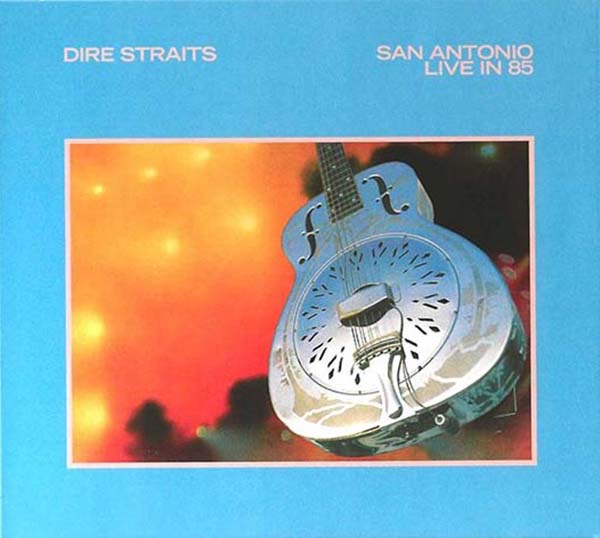
It was a joy to revisit—and have a better aural appreciation for—Chris White’s multiple flute passages and the late, great Jack Sonni’s chucka-chucka island-flavored guitar lines that both serve to sweeten the arrangement of the extended show opener “Ride Across the River.” “Espresso Love” (originally from 1980’s Making Movies) gets a nice vocal/sax postscript, and “One World” appears as “one we’ve changed a bit,” as per how Knopfler IDs it, with a revised intro and even funkier choruses—though the overlapping outro/intro to “Romeo and Juliet” (also from Making Movies) had to fade out at the end of LP1, Side One and then fade back in on LP1, Side Two. (Digitally, of course, the transition is much smoother.)
The extended guitar runs on “Sultans of Swing” (the band’s breakout track from 1978’s Dire Straits) are beyond epic—and worthy of the lengthy audience ovation following it that precedes the “Why Worry” tone break (albeit appearing in that much shorter form here, though Knopfler would reinstate its lengthier passages on subsequent solo tours). A meatier approach to “Wild West End” (also from Dire Straits) closes LP2, Side Four, and I continue to marvel at how keyboardists Alan Clark and Guy Fletcher updated the carnival/calliope opening to “Tunnel of Love” (from Making Movies) on LP3, Side Five—not to mention how the guitar-and-piano-led solo sections cleverly differ from the epic version on 1984’s Alchemy 2LP set that chronicles the previous tour—while the always elegiac if somewhat melancholy nature of the set closer, “Going Home,” at the end of LP3, Side Six, gets me every time. (Hmm, I might just request that pivotal Local Hero song be played at my funeral someday—a maudlin thought for another time, I realize, but still.)
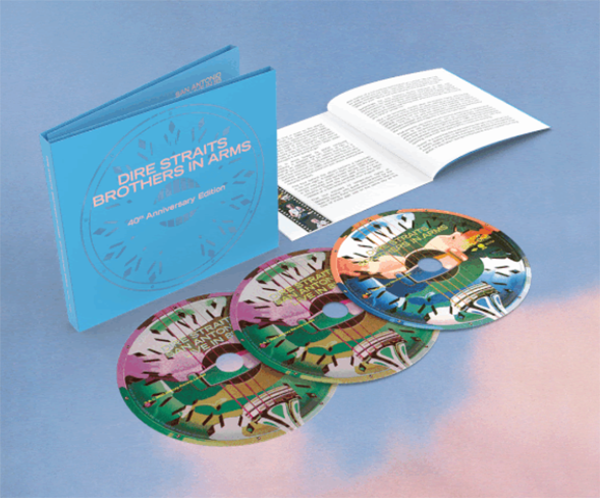
Those of you more digitally inclined are indeed welcome to seek out the 3CD set to get your San Antonio live jones another way, and it certainly looks quite pristine in how you see it presented above. That said (Pt. 3)—as is typical for most multi-panel digipaks these days that contain no plastic-tray elements whatsoever, my BIA40 3CD set’s spine inevitably arrived all bent and crackled right down the middle from stem to stern because it’s just not sturdy enough to withstand the pressure from the more rigid, folded-in left and right sleeve quadrants. It’s a small price to pay to be a completist, I suppose, but seeing how this even happens with 2CD digipaks nowadays, it’s par for the paper-only course.
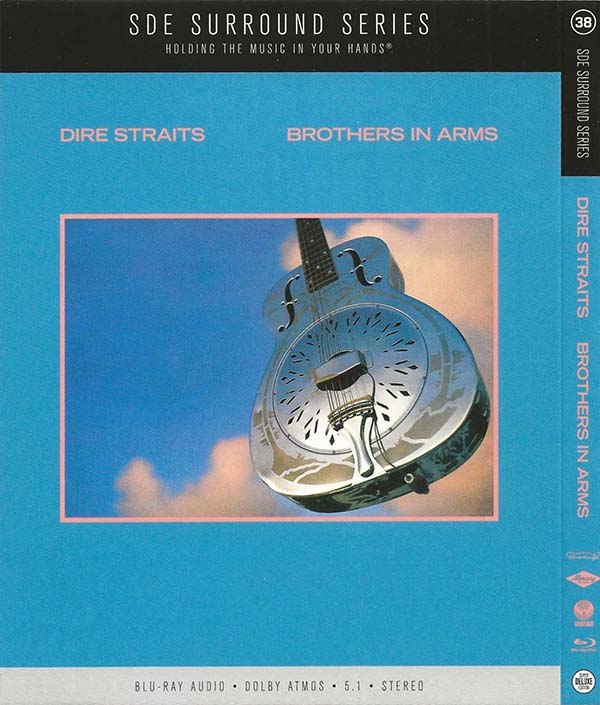
What I was most looking forward to in this celebration was, of course, cueing up Guy Fletcher’s Atmos mix on the BIA40 Blu-ray—a mix you can also access here in the Apple Music universe.
One thing I love about this BD is that it offers a variety of mix options: 1) Fletcher’s 2022 Dolby Atmos mix, 2) Fletcher’s 2022 Dolby Atmos Instrumental Mix, 3) the 2005 DTS-HD 5.1 Mix done by Chuck Ainlay, 4) the 1985 CD Version Stereo Mix, and 5) the 1985 Vinyl Version Stereo Mix, the latter two having been done by the purview of the original aforementioned co-producers, Dorfsman and Knopfler. In other words, you can access the mix (or mixes) of BIA that you already know and love, but also have the option to hear what Fletcher has done—at Knopfler’s behest and approval—to enhance BIA for its full 360-degree presentation.
Last year, when Fletcher and I discussed the Atmos mix he had done for Knopfler’s stellar 2024 solo album One Deep River (which you can read about here), we also talked about what he had done for BIA in Atmos. “With an album that’s so seminal—one that’s so big in people’s worlds and in people’s lives—the last thing you want to do is to take it away from something that they know,” Fletcher admitted. “So, I was playing it safe, because I think it’s only respectful to do that because it means so much to so many people. I didn’t want to go crazy on anything, really, but just enhance the experience as much as you can with using the Atmos format.”
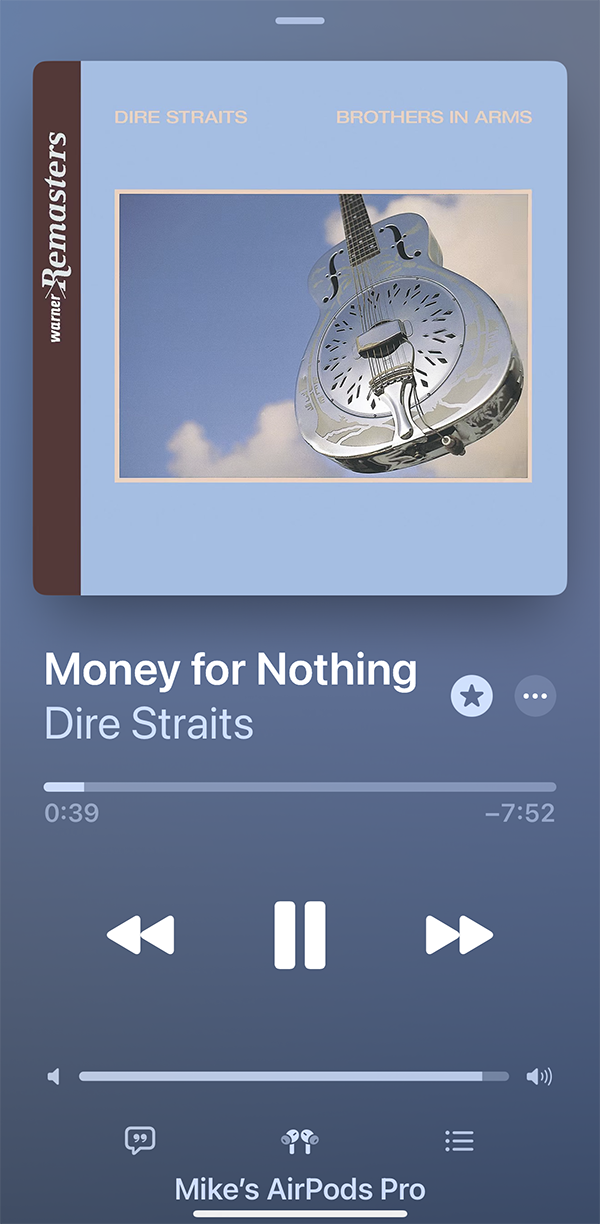
Fletcher is being cautiously modest here—but, admittedly, with good reason. Even so, the way the linchpin track “Money for Nothing” unfolds in Atmos is nothing short of how Atmos mixes should be done. The opening keyboard spirals rotate clockwise through every channel, leading to Terry Williams’ furious drum buildup/crescendo, which spreads even wider across the full soundstage than it does in the still-amazing 5.1 mix by Chuck Ainlay. (We will, however, give the Apple universe a few points off for using the incorrect mid-1990s Warners Remasters Series album cover option for visual accompaniment, as seen above via my separate AirPod Pros listening sessions.)
Brief sidenote—during a hi-res-audio panel I hosted at CES in January 2018, Ainlay told me the following about his 5.1 BIA mix: “The mixing of it was just a trip. All I had was one track sheet. It had what the effects were but there was no recall available, so it was literally listen to the original record and try to duplicate it, because I didn’t want to change anything. It was one the best recordings—one of ‘those’ records—so you can’t change it, but I wanted it to feel a little warmer. It was really about duplicating the record as close as possible, but then just expanding it a little bit.” And that Ainlay did do, to the best degree possible given the max of what could be done in 5.1—and you can cue his version up on the BD to hear it for yourself, if you haven’t already done so via the 20th anniversary SACD version that also includes it.
Back to “Money” in Atmos! When the seas fully part and Knopfler’s massive, signature Les Paul Junior guitar pronouncement comes to the fore, it rises widely and mightily into the clouds, soon enough wholly owning the listening space around you. For added enjoyment, cue up the instrumental-only version to hear how Knopfler’s comp riffs spread wide on the verses, and then enjoy the center-left cowbell in the back half of the track that’s less prominent in the stereo mix options.
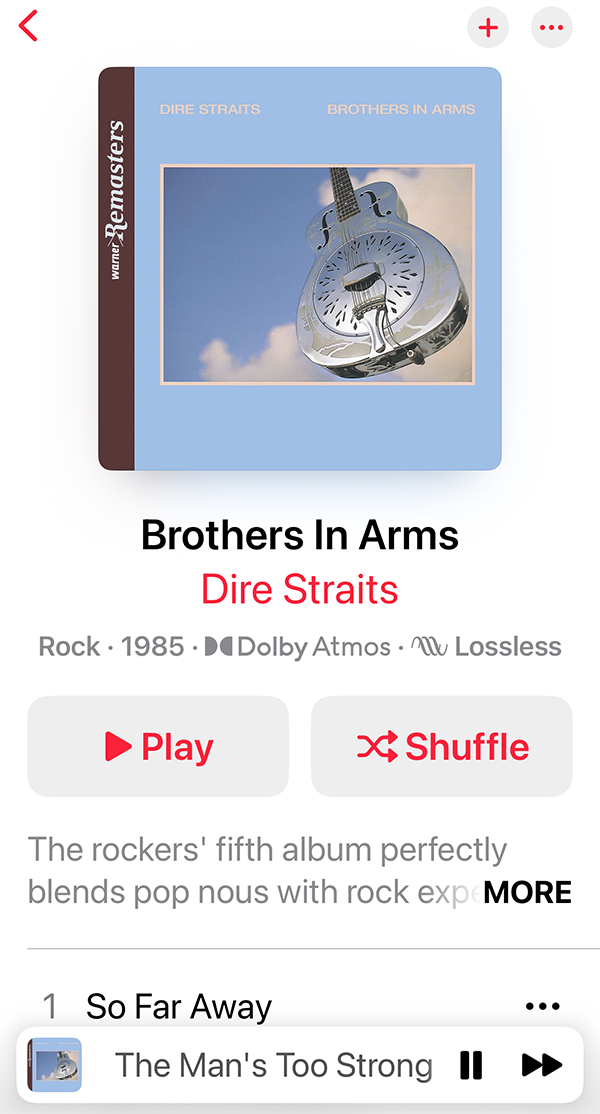
Some interesting revelations come in the middle of “The Man’s Too Strong” (shown above in the Apple Music universe). With the vocals stripped away in the instrumental-only Atmos mix on the BD, I could better appreciate Knopfler’s country/bluegrass comp-picking that foreshadows some of the directions his later solo material would take, plus I heard some honky-tonk piano playing behind him down the middle that I’d never really picked up on before, and Fletcher’s all-aswirl Yamaha DX1 synth work is beyond masterful.
I could go on, as every BIA track in Atmos has its own level of 360-degree glory, but I did ask Fletcher what his own personal favorite is. “Probably my favorite experience of mixing that album in Atmos was tackling the title track, for so many reasons,” he replied, “but it was tough to retain the dynamic of that track with Atmos. It’s just such a cool and different recording, one of the first songs in that style that Mark had ever done. As long as you still get the emotion he intended from the Atmos mix, then I’m happy. I mean, it’s such a great song, it’s hard to go wrong with it.”
Mission accomplished, Guy! Or, to borrow a line that I’ve borrowed before—that’s the way you do it. If you can get your hands and ears on any/all versions of Brothers in Arms in its myriad of 40th anniversary incarnations—though the Atmos mix is my most preferred and most recommended, of course!—you’ll truly be glad you did. It’s got the action, and it’s got the motion.





